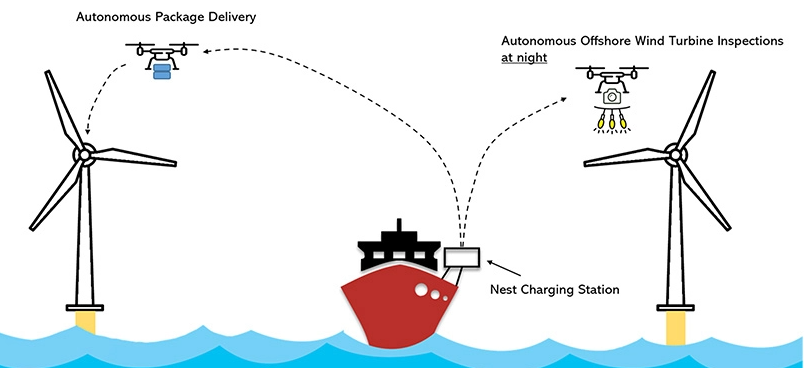
Upteko is tasked with programming the fully automatic drones and SDU with developing the software for route planning and for autonomous inspections of the wind turbines. The drones will take off from ESVAGT’s ships and carry gear and tools to a nacelle of a Siemens Gamesa offshore wind turbine.
The project partners say that the drones will also be able to carry out other tasks from the vessels.
Today, spare parts are transferred by SOVs, which takes a long time even with careful planning and will take even longer as offshore wind farms get bigger. The solution being developed within the FOD4Wind project can reduce downtime, and thus eliminate fixed costs for servicing offshore wind, and also cut emissions from O&M operations, according to Siemens Gamesa.
“If we can replace sailing with drone flights from larger ships, then many of the trips around the wind farm will be saved. There is great potential in that – both in terms of time and CO2 emissions”, said Benjamin Meinertz, partner in Upteko.
Based on estimations of the project team, with 70 installed charging stations with drones, the annual effect in 2030 will be reduced downtime of 12,250 hours, increased energy production by 39,200 MWh, reduced costs for service by EUR 57 million, additional employment of 180 employees, and 13,000 tons of CO2 reduction.
“In the last thirty years, we have made important steps in our journey towards decarbonization. But we only have thirty years left to achieve our net zero goals. This means we will need to deliver a lot more, a lot quicker – and be aggressive in the pursuit of full decarbonization. This is a fundamental change that we will only achieve if we succeed in industrializing the wind turbine service”, said Lars Holm Nielsen, Head of R&D Service Operations at Siemens Gamesa.
The project, which runs until the end of 2024, is first working with payloads of 12 kilograms, with a long-term goal for the drones to be able to carry a cargo of up to 100 kilograms.
FOD4Wind is supported by the Energy Technology Development and Demonstration Program (EUDP) and has a total budget of EUR 2.2 million. The project was previously supported by the European Regional Development Fund.
Back in 2020, ESVAGT and Siemens Gamesa teamed up with Ørsted on a project exploring the use of drones that could deliver cargo weighing up to 3-4 kilograms directly to an offshore wind turbine nacelle
This was a six-month project that ended in June of the same year. Under this project, called Operative package deliveries by drones and sponsored by the European Regional Development Fund, the three companies cooperated with several subcontractors on a solution for the usage of drones for O&M operations.